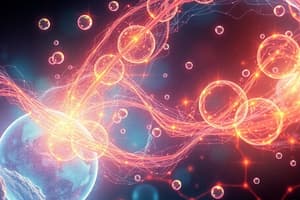Podcast
Questions and Answers
What is the method used to find the rate of a reaction when examining the change in mass as gas is released?
What is the method used to find the rate of a reaction when examining the change in mass as gas is released?
- Measuring the increase in product volume
- Measuring the decreasing mass of a reaction mixture (correct)
- Monitoring light transmission
- Calculating the temperature change
The steeper the gradient on a reaction graph, the slower the rate of reaction.
The steeper the gradient on a reaction graph, the slower the rate of reaction.
False (B)
How do you determine the rate of a reaction at a specific time using a reaction graph?
How do you determine the rate of a reaction at a specific time using a reaction graph?
By drawing a tangent to the curve and calculating its gradient.
To calculate the mean rate of a reaction, you need to know the total change in ______ over the total time taken.
To calculate the mean rate of a reaction, you need to know the total change in ______ over the total time taken.
Match the following methods of measuring reaction rates to their descriptions.
Match the following methods of measuring reaction rates to their descriptions.
Which unit is typically used to measure the rate of a chemical reaction?
Which unit is typically used to measure the rate of a chemical reaction?
The reaction is considered complete when no change in the amount of reactants or products is observed on the graph.
The reaction is considered complete when no change in the amount of reactants or products is observed on the graph.
What happens to the reaction mixture's mass when a gas is produced during the reaction?
What happens to the reaction mixture's mass when a gas is produced during the reaction?
In reactions that form a precipitate, the light passing through the solution ______ over time.
In reactions that form a precipitate, the light passing through the solution ______ over time.
Which factor does NOT affect the rate of a chemical reaction?
Which factor does NOT affect the rate of a chemical reaction?
Flashcards
Rate of reaction
Rate of reaction
The speed at which a chemical reaction occurs, determined by how quickly reactants are used up or products are formed.
Reaction Graph
Reaction Graph
A graph plotting the concentration of reactants or products against time, showing how the reaction progresses.
Tangent
Tangent
A straight line that touches the curve at a single point, showing the instantaneous rate of reaction at that time.
Gradient
Gradient
Signup and view all the flashcards
Decreasing mass
Decreasing mass
Signup and view all the flashcards
Increasing gas volume
Increasing gas volume
Signup and view all the flashcards
Decreasing light
Decreasing light
Signup and view all the flashcards
Precipitate
Precipitate
Signup and view all the flashcards
Constant rate of reaction
Constant rate of reaction
Signup and view all the flashcards
Changing rate of reaction
Changing rate of reaction
Signup and view all the flashcards
Study Notes
Rate of Reaction
- The rate of a chemical reaction describes how quickly reactants turn into products
- Reaction rate is crucial in industry to make products efficiently and economically
- Reaction rate is important in biological systems to maintain correct processes
Calculating Rate at a Specific Time
- Reaction graphs show reactant/product changes over time
- To find the rate at a particular time, draw a tangent to the graph at that point
- Create a right-angled triangle where the tangent is the hypotenuse
- Calculate the gradient (slope) of the tangent - gradient = rate
- Units for rate are commonly g/s, cm³/s, or mol/s
Measuring Rate using Decreasing Mass
- If a reaction produces a gas, the total mass decreases.
- Measure mass at regular intervals
- Data loggers can continuously monitor mass loss
Measuring Rate using Increasing Volume
- If a reaction creates a gas, measure the gas volume at set intervals.
- Gas syringe collects and measures
Measuring Rate using Light Transmission
- Some reactions produce precipitates, making the solution cloudy
- Light passing through the solution is reduced - measured
- Easier than "disappearing cross" method
Mean Rate of Reaction
- Calculated for a specific period of time
- Equal to the quantity of reactant used or product formed divided by the time taken
Studying That Suits You
Use AI to generate personalized quizzes and flashcards to suit your learning preferences.




